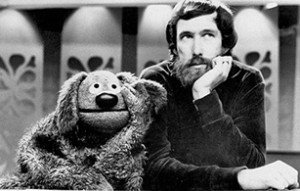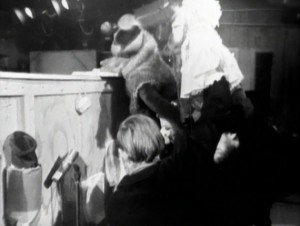The Muppets on Puppets
In June 1968, Henson Associates filmed a special for public television (which at the time was called National Education Television) at Hershey, Pennsylvania’s WITF-TV, making it the first-ever Muppet special to air, although unlike most of the others, it wasn’t a narrative but rather a behind-the-scenes look at the Muppets, hosted by Jim, called The Muppets on Puppets–a rarely seen program today that won the NET Award for Best Educational Television Show of 1968, and which, thankfully, Disney included as a bonus feature on the third season of The Muppet Show DVD set. And for a Muppet and Henson devotee, it is a treasure trove.
For one, after watching so much of Jim’s creative output but with he himself nearly always hidden from view, it is absolutely remarkable to see him, as himself, take center stage, and even more so, discuss his process and techniques so directly. Jim may not have come into puppetry as a first choice but you can tell by this point that he had fully embraced it as an art form–even if it wasn’t the only one he felt drawn to–due to the level of passion and knowledge he brings to this show. Watching this today is effectively like attending a masterclass from arguably the greatest puppeteer who has ever lived, in addition to being one of the greatest creative minds the world has ever seen.
I’ve heard that Jim was never fully comfortable in the spotlight, preferring to recede behind the camera, but you wouldn’t necessarily realize that here, likely because he is speaking on a topic so near and dear to his heart and which he knows so much about. Jim clearly realized that, in order to move forwards in puppetry, it would be crucial to immerse himself in the past. And here, he demonstrates this by not only showing how his Muppets are operated but with examples of puppetry throughout history and various cultures, including ancient shadow puppets from India, Punch puppets from 19th century England, and more.
And besides seeing Jim speak about and even work his puppets, we also see Frank Oz, Jerry Juhl–both, like Jim, looking much younger than I’m used to seeing them in interviews and/or as themselves–and, perhaps, most excitingly, Don Sahlin, Jim’s master puppet builder, who, as I’ve mentioned before, was crucial in bringing what we think of as the Muppet look to life. Watching him put together rudimentary Muppets on screen is an absolute thrill, even though he seems much less in his element speaking on camera than Jim–which is interesting, because (a) he was a very fun, wild, prank-loving character in real life, from everything I’ve read about him, and (b) there’s very little footage of him today, due to his untimely death in 1978.
But it’s great to see all of them work both on stage and off. In one awesome bit, the men present a complete Muppet fairy tale sketch, and then afterwards, the sketch is replayed from their perspective, backstage. The chance to see them all crammed behind the high set, their arms all up in the air, each of them picking up and discarding various puppets, working together to operate some, such as Rowlf, and creating all of the visual and sound effects from the back is nothing short of a remarkable opportunity that manages to make their process seem even more magical. Unlike some backstage secrets that take away from one’s ability to suspend one’s disbelief, this footage put me in awe of how, with such simple touches, they were able to create something so uniquely brilliant. We even get to see the TV monitor on the floor that they watched in order to see their performances, which, as I explained in an earlier post, was Jim’s innovation that is now standard practice for filmed puppeteers.
From today’s perspective, it’s also remarkable to again see how central Rowlf was to the Muppets back then. In fact, he was the star, much more so not only than Kermit but Jim, as well, who wasn’t a household name the way he was. And so the special is sculpted in such a way to make as much use of Rowlf as possible, also offering the extremely rare (if not unheard of anywhere else) opportunity for Rowlf and Jim to interact with each other. This wasn’t usually possible, because Jim would generally operate Rowlf’s head and right arm with another puppeteer handling his left, and would meanwhile be doing the vocal performance, as well. Here, Rowlf’s dialogue has clearly been pre-recorded and two other puppeteers (probably Oz and Juhl) are working him, so these two friends can finally talk together on screen, and, again, it is pure magic.
The special begins with a wonderfully meta introduction, in which Rowlf demonstrates what a puppet is by putting one on his right paw, with the added humorous twist being that the puppet on said paw refuses to do what he wants it to do, just standing there, doing nothing, until it suddenly takes a stick and starts to hit Rowlf with it–such a classic example of Muppet humor, a puppet failing to operate another puppet, which then gets out of control, despite the fact that the original puppet should have been controlling him in the first place but actually isn’t because the unspoken truth is there’s a human making everything happen underneath it all. This provides a perfect lead-in to Jim’s ensuing conversation with Rowlf in which he reveals to him the harsh truth that he, Rowlf, is actually a puppet himself!
Pages: 1 2



